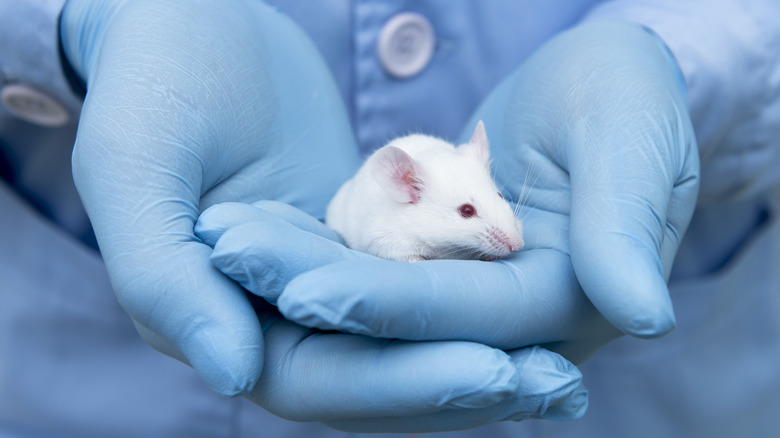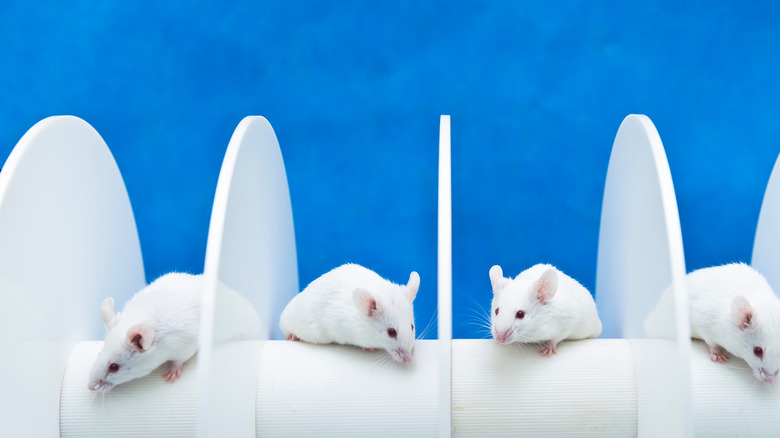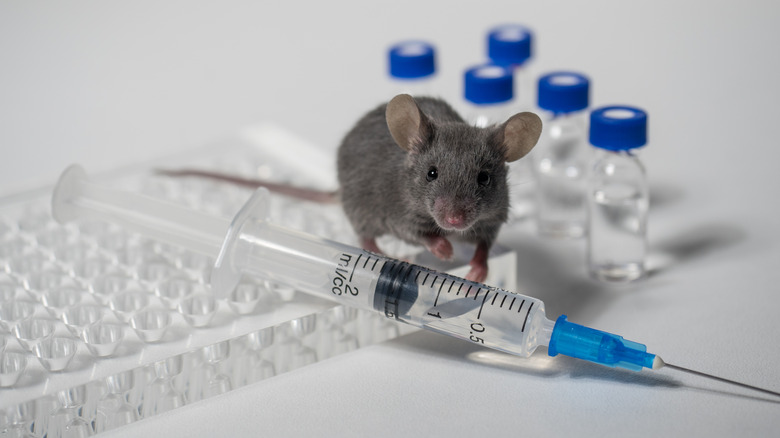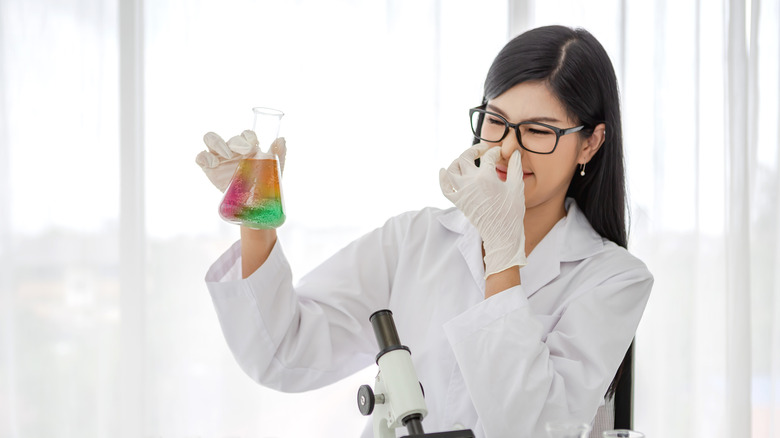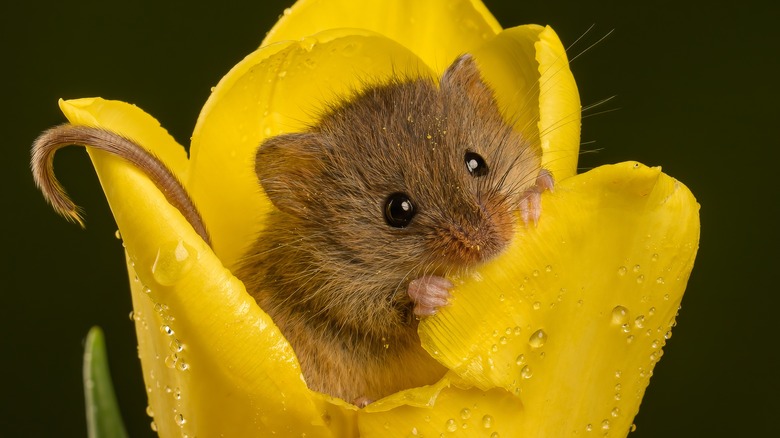Why Female Scientists Are More Successful In The Lab Than Men
Let's say you're attacked by a wolverine. During the attack, sobbing over your wound isn't as important as running away as soon as possible. Your body has an amazing way of blunting pain during moments such as this (via Progress in Neurobiology). Stress-induced analgesia (SIA) is an ability shared by many mammals that allows painful sensations to be dampened or blocked out by our brains. This power is activated when we're intensely fearful or anxious. But now, previous findings on exactly how SIA works are being called into question. In a stunning paper from Nature Neuroscience, a new set of researchers confirms what many scientists have feared for years: systemic sexism is messing with their results.
According to the American Association of University Women, women make up only 28% of the science, technology, engineering, and math (STEM) workforce. The biological sciences have the smallest gap in male-female disparity, with women making up 46% of the ranks. Without those women biologists, we might not have discovered some surprising effects women have on the experience of pain, depression, and anxiety. Apparently, female researchers are getting important results in SIA, pain, depression, and anxiety research that male scientists can't.
Mice don't like the smell of human men
SIA is influenced by an animal's age, sex, current environment, and their prior experience with pain (via a review in Progress in Neurobiology). It works by triggering the same systems in our bodies that respond to opioids and cannabis. Unfortunately, new research suggests this magic pain-dampening power is also activated in mice just from male scientist handling.
Back in 2014, a pain research study out of Nature Methods found that human male body odor set off the SIA of mice and rats. To study the effect of human smell, researchers collected T-shirts worn for 24 hours by male or female experimenters before being stuffed in air-tight bags for that day's experiment. Just having a male-worn T-shirt in the room was enough to get the mice hiding or dampening their pain. This SIA effect occurred in spite of scientists and veterinary technicians dawning clean lab coats, one-time use gloves, and disposable laboratory gowns before working with animals. But if middle school taught us anything, it's that body odor and cologne have the potential to permeate through multiple layers. So, for countless years and thousands of studies, results have been mucked up by the smell of human males.
Male experimenters change the behavior of animal subjects
Professor Todd Gould and his team at the University of Maryland study antidepressants and mood disorders. In an email interview with Grunge, he said he gives "full credit" and thanks the 2014 Nature Methods paper for "enlightening us" on the effects of human experimenter's sex on animal behavior. Building off that foundation, Gould's big study in Nature Neuroscience exposed the effects of male versus female scientists on mouse behavior, including how a scientist's sex changes the effectiveness of drugs. Male scientists and their smell produced a greater stress response in mice — the mice spent time investigating female body odor but found the male smells aversive. The smell of a male-worn T-shirt brought on depressive and anxiety-like behavior, and male-handled mice also seemed to give up more easily when put in challenging circumstances.
The mice also didn't want to lick themselves. Licking and grooming are important for the health of rodents — just as you'd be concerned if a friend stopped bathing, the licking and grooming behavior of mice provides insight into their mood. The sucrose splash test is meant to explore the side of depression that involves a lack of self-care. In this assay, sugary liquid is sprayed on a mouse, and the amount of time it takes before the mouse licks/grooms the liquid off is measured. Mice handled by males had more of a gloomy "what's the point?" response, taking longer before expressing self-care.
Stressful smells enhance antidepressant drug effects
Taking this research a step further, Todd Gould and his team looked at how stress-induced analgesia could interact with drugs designed to treat depression (via Nature). Ketamine has antidepressant effects at certain doses, and the team discovered an interaction between male experimenters and ketamine's antidepressant-like effects on mouse behavior. In particular, the heightened stress and anxiety from a male handler gave ketamine treatments an extra boost. Suddenly, with ketamine on board, male-handled mice were outperforming female-handled mice, showing low signs of depression-like behavior. And the effect was specific to male body odor — other types of stress couldn't achieve the same strange interaction found with the human male scent.
This gave the researchers some ideas on where in the brain this effect was happening. Low and behold, a special set of brain cells in the area that processes smell — the entorhinal cortex — was part of the stress response system. Like toggling with the audio/visual cords to a TV, scientists got to understand how this system affects behavior. By turning the activity of these cells on and off, they could eliminate the fear response to human male smell or make mice act as though a human male was present.
Scientists can't ignore confounding effects of sex
The muddling effect of experimenter sex has been known and studied extensively in human pain research for years. For example, male participants in one study reported less pain to an attractive female experimenter than to a male (via Pain). Scientists have the potential to be biased too. Men and women observing videos of people experiencing discomfort underrate the pain experienced by males and overestimate female pain (via Pain). So, with all this background on the effect of experimenters, why is this new research such a surprise?
It's not. Animal researchers have known their subjects can detect experimenter sex but didn't want to consider that their animal subjects were biased (via Comparative Medicine). Perhaps results from previously male-dominated laboratories were more clear-cut. Regardless, now that the ratio of women to men is shrinking, the confounding effects on laboratory animal research are undeniable. But how can scientists ever address all the various factors affecting behavior during a study? Todd Gould emphasizes the importance of consistency. "Keep as many things as you can consistent throughout and between experiments," he told Grunge. He also warns researchers to "pay attention to, and keep an open mind regarding, confounding factors," because "you will be surprised by the impact" small changes in methods can make in biology.
More females in science will help avoid bias results
Todd Gould's paper exposes an oversight that a lot of researchers were content to ignore. Other than work on antidepressants and mood stabilizers, he believes these findings will have a significant effect on cancer research. "Growth of tumors and efficacy of treatments is affected by stress," he explained to Grunge. "It is one of the fields also suffering from this replicability crisis," he added, highlighting the problem where similar studies produce different results. Gould is currently corresponding with the National Cancer Institute about this issue.
Having women in science isn't just a good idea because it's ethically sound. Hopefully, these discoveries will encourage the inclusion of women in more than the biological sciences. Because who knows where other large sex blind spots persist? This insidious confound might be lurking in lucrative STEM fields such as computer science and mathematics (25.2% women) and engineering (16.5% women), per the American Association of University Women.
Future research on stress-induced analgesia (SIA), depression, and anxiety in mice will have to consider the sex of the experimenters. But is the field of neuroscience ready to accept this? Are they going to shift their practices with this new evidence, like good researchers, or continue to ignore the smell of males? Best case scenario, they start reporting the sex of the researchers (via Science Advances).
